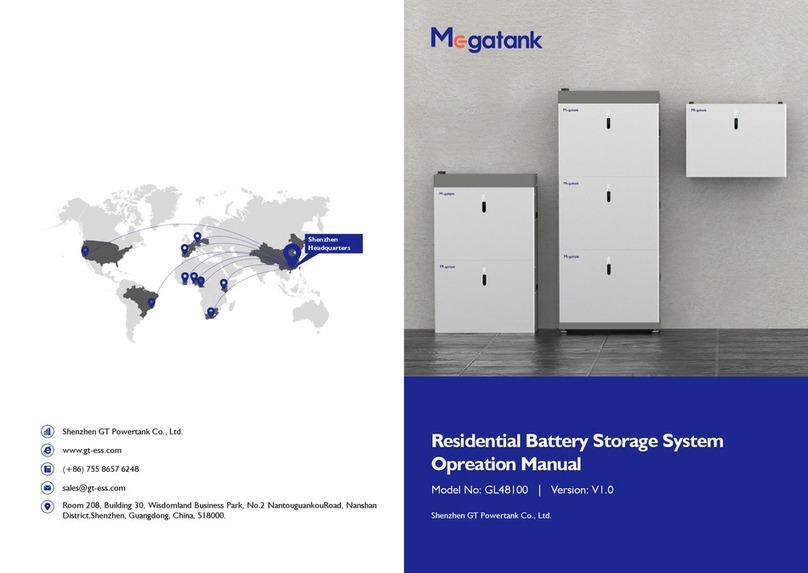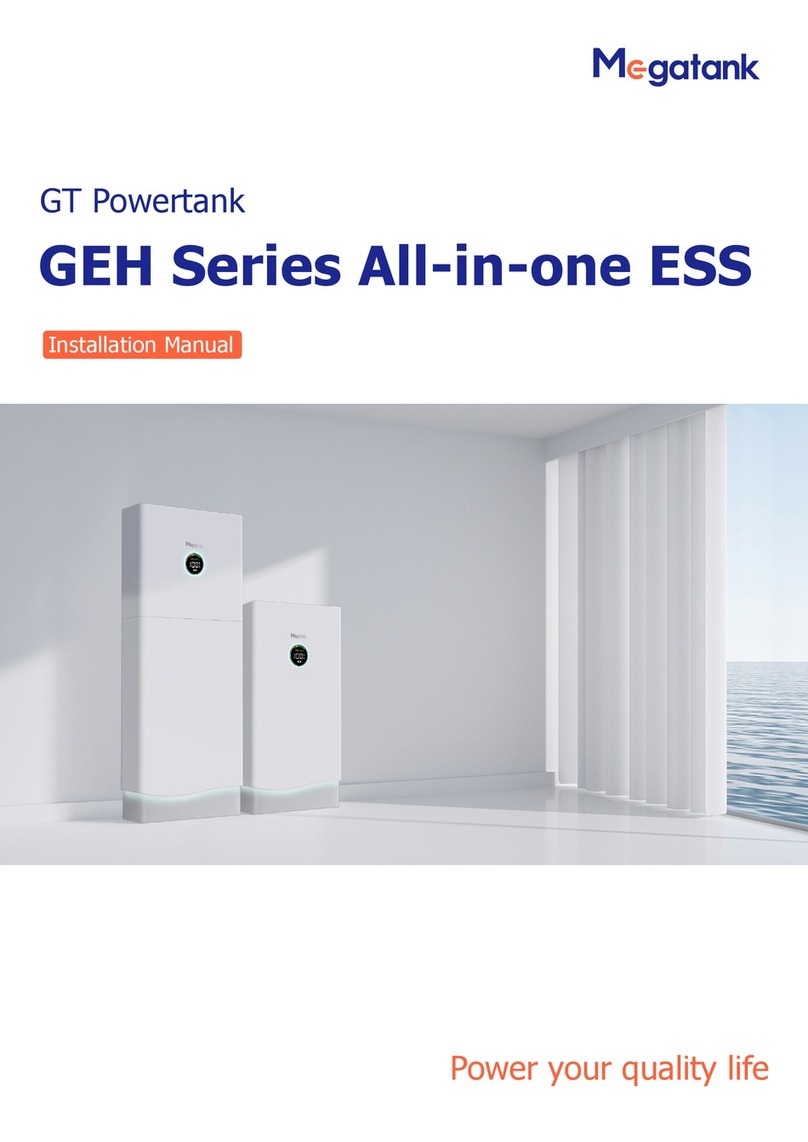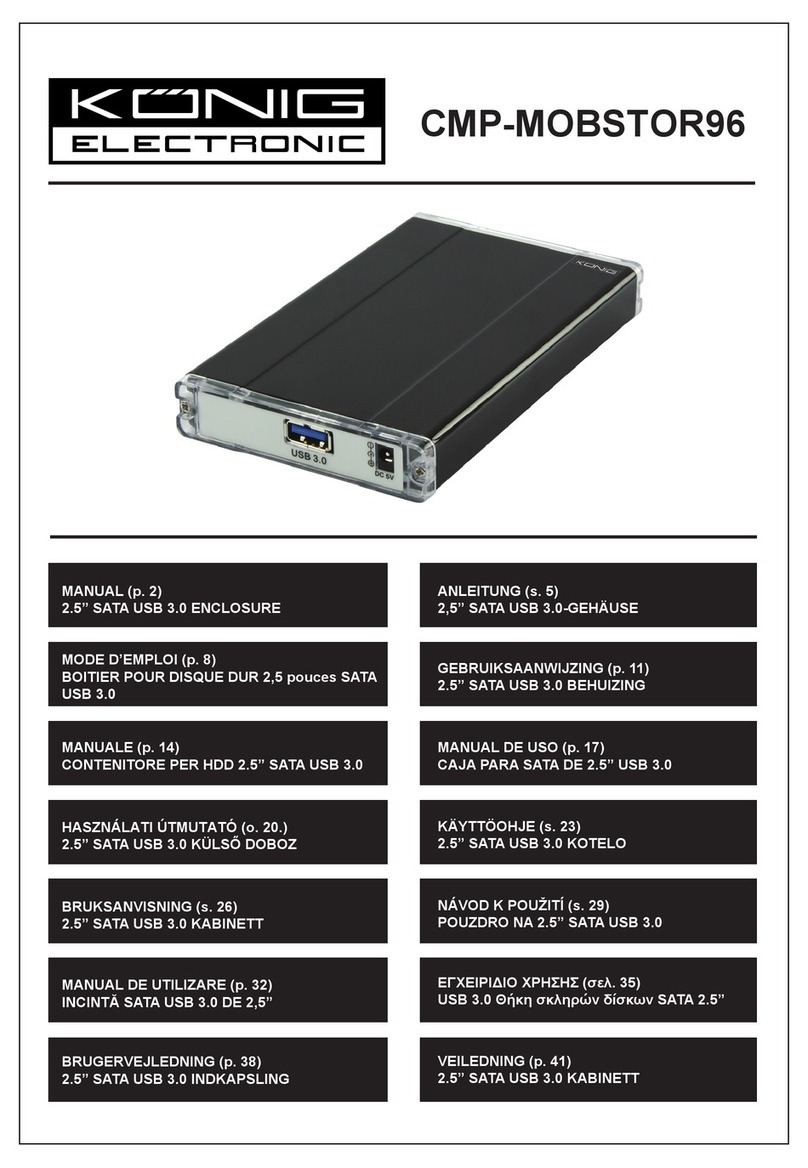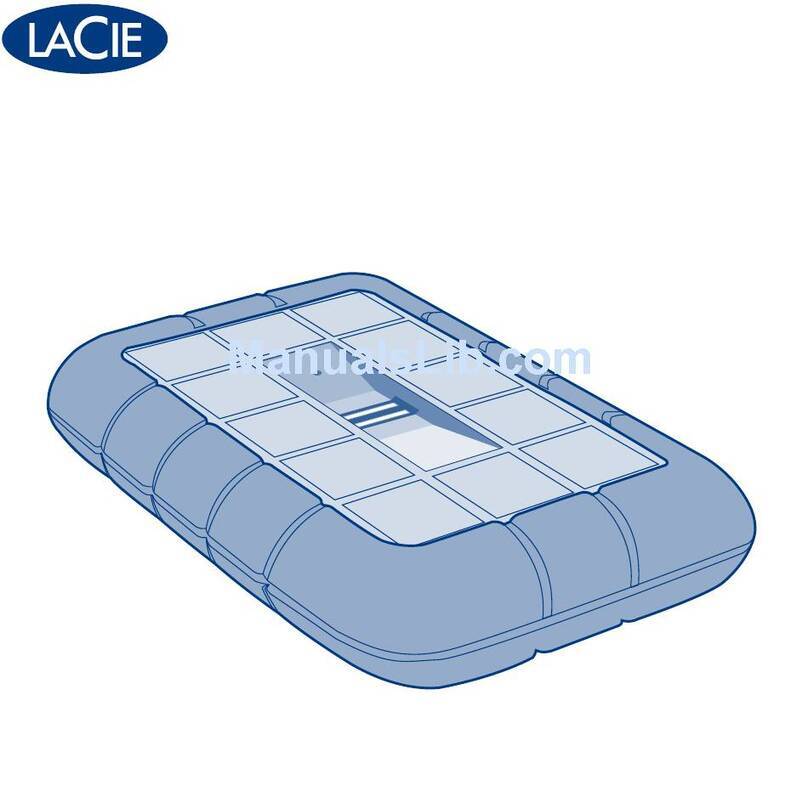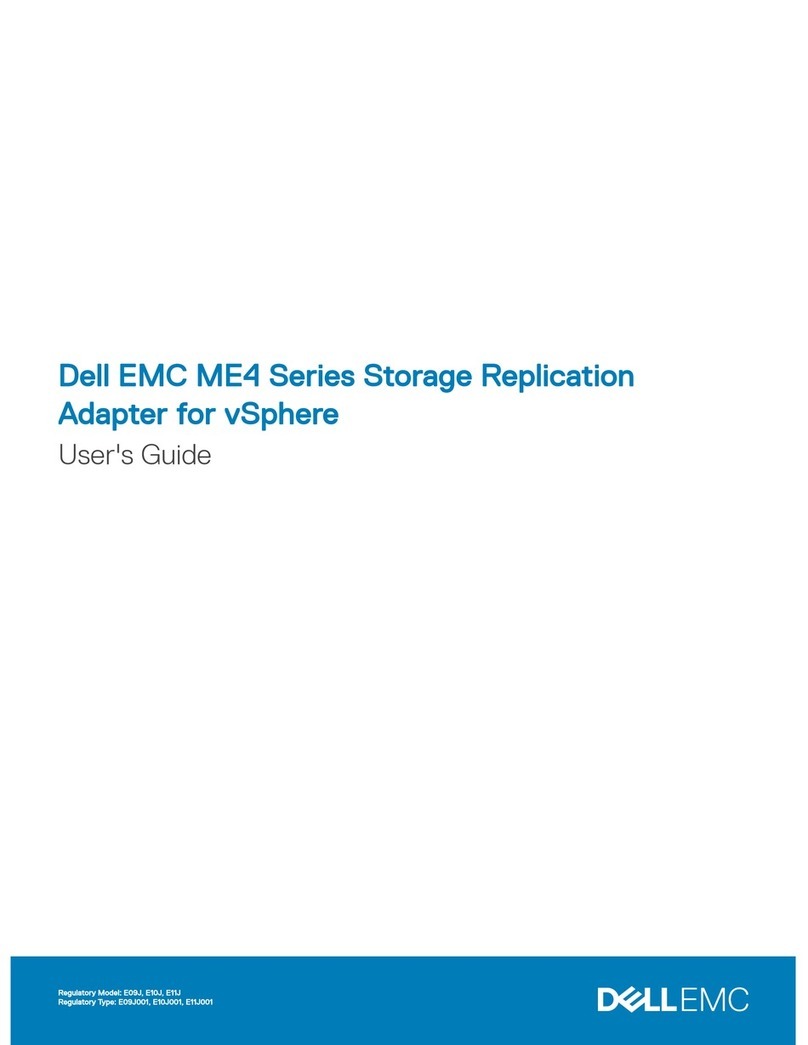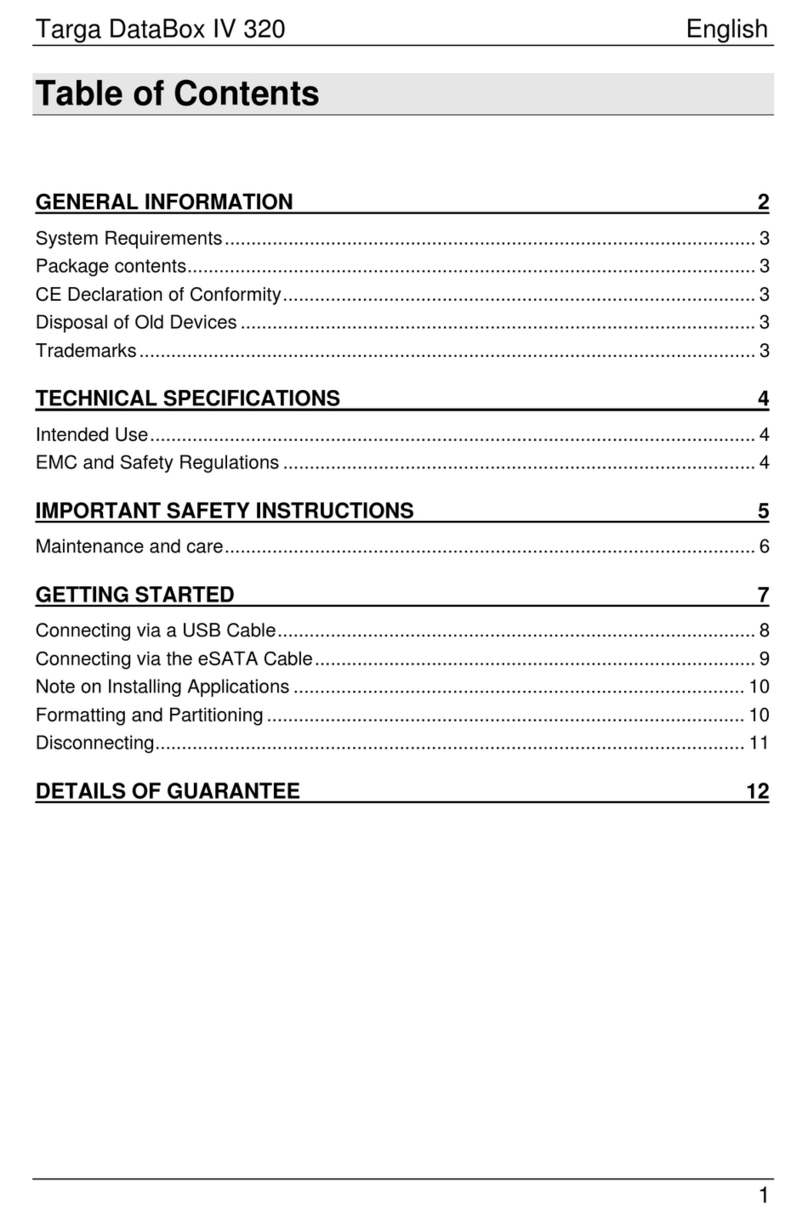Megatank GL48100 Guide


1
GL48100 User & Installation Manual
General instructions
This manual contains important instructions for our GL48100 battery storage system. This manual includes all the
information related to GL48100’s specifications, interface, and user guide. Please read this manual carefully before
installing your equipment and retain it for future reference.
Compatible inverter
Dimension
Driving load performance
Model GL48100 Mounting Floor-mounting / wall-mounting
Compatible with
Off-grid and on-grid inverter ≤5kW (Single GL48100)
If you are using a grid-tied inverter or your inverter operates in grid-tied mode, please
ensure that the communication between your inverter and GL48100 is properly connected
and functioning correctly.
Battery nominal voltage Inverter
efficiency
Load start-up
instantaneous power Start-up time Note
51.2V 80%
5.3kW≤P<8.2kW <10 seconds Instantaneous power is an
ideal value only for reference.
It will be affected by your
inverter’s efficiency.
8.2kW≤P<12.2kW < 3 seconds
Unit:mm

2
Ports
Ports are concealed within the left and right handle covers of GL48100. Low voltage ports are on the left side, while
high-voltage ports are on the right.Please open the handle covers to connect the power & communication cables.
Low-voltage port
RESET Reset button Reserved for after-sales service purposes only.
ADDR Address switch
To set the battery address in parallel operation. The
master battery is the one that communicates with the
inverter. Its address is 01.
OUT Dry contact
CAN/485-2
Two RJ45 ports. Both CAN port & RS 485 can be used to communicate with an inverter.
RS485-2 port can be used to monitor all parallelled ’s working status on BMS
Monitoring software.
RS232 Reserved.
RS485-1
There are two RJ45 ports for communication between GL48100 systems in parallel
operation (daisy-chain). The RS485-1 port can be used to monitor the working status
of all GL48100 systems through the BMS upper computer when the master GL48100 is
not connected to the inverter.
ON /OFF Button Press the ON/OFF button to power your GL48100 on or off.
High-voltage port

3
Ports
We recommend using CAN communication between GL48100 and your inverter.
Some inverters on the market have both RS485 and CAN ports. If your installer uses the CAN port for communication
with the GL48100, please disconnect the RS485 network cables to avoid potential communication loss between the
GL48100 and your inverter.
For multiple
GL48100s daisy-chain
communication
Pin 1 & Pin 8 RS485-B
Pin 2 & Pin 7 RS485-A
Pin 3 & Pin 6 GND
Pin 4 & Pin 5 NC
For inverter
communicatio
n and service
purposes
Pin 4 CAN-H (to inverter CAN-H)
Pin 5 CAN-L (to inverter CAN-L)
Pin 3 & Pin 6 GND
Pin 1 & Pin 8 RS485-B (to inverter RS485-B or BMS
software communication)
Pin 2 & Pin 7 RS485-A (to inverter RS485-A BMS
software communication)
Two RJ45 ports
Two RJ45 ports
GL48100 communication pins with a inverter
• Please consult your inverter
manual for the inverter-battery
communication pin definition
first.
• Always remove unnecessary
wires from the RJ45 connector,
as some inverter
communication pins carry
voltage and pose a potential
risk of damaging your BMS.

4
The indicators
When your GL48100 is on, the RUN indicator blinks green every second. If an alarm occurs, the ALARM indicator
blinks red every second your GL48100 can still be charged if the alarm indicator blinking red, but discharging may
be limited under certain conditions (low battery percentage). If GL48100 is under protection, the ALARM indicator
turns solid red, limiting charging and discharging functions.
The POWER indicator - Charging
The POWER indicator - Discharging
Discharging
75%-100%
51%-75%
26% - 50%
6% -15% Low battery. Please charging the batteries as soon as you can.
Do not power any loads.
1% - 5% The GL48100 will stop discharging to protect itself. If you see this
indicator, please charge the battery immediately.
0% (Blinking green) The GL48100 may enter sleep mode. To wake it up, please use a
low-current battery charger.

5
The charging alarm & protection indicator
When Alarm & Protection Conditions Indicator Note
Charging
Over-voltage protection
Battery voltage ≥
56.8V Off
Higher charging voltage
negatively affects battery life.
Please adjust your inverter's
parameters accordingly.
Cell voltage ≥ 3.65V
Over- current alarm ≥105A Blinking
red
You can still charge/discharge
your GL48100.
Over-current protection ≥115A Solid red
GL48100 stop charging. Please
reduce your charging current.
You can discharge to power your
loads.
Over-temperature alarm
(Battery) ≥50°C Blinking
red
You can still charge your
GL48100. Please reduce your
charging current.
Over-temperature
protection (Battery) ≥55°C Solid red
GL48100 stop charging.But you
can still discharge GL48100 to
power your loads. Please
disconnect some of your heavy
loads < 2.5kW to reduce the
heating produced by the battery.
Under-temperatue
alarm(Battery) ≤5°C Blinking
red
You can still charge your
GL48100. Please reduce your
charging current to 20A.The
GL48100 will be able to charge
when the enviroment
temperature > 10°C.
Under-temperatue
protection(Battery) ≤0°C Solid red
GL48100 stop charging.You can
discharge to power your loads.
The GL48100 will be able to
charge when the enviroment
temperature > 5°C.
If improper inverter settings or long load shedding periods lead to an abnormally flat battery percentage in the
GL48100, your inverter may not charge it effectively. This could result in two scenarios:
• A solid green power indicator, or
• A blinking green power indicator with a solid red alarm indicator.
In these situations, please reach out to your installer or request technical support services.

6
The Alarm & Protection indicator (Discharging)
When Alarm & Protection Conditions Indicator Note
Dis-
charging
Low-voltage alarm
Battery voltage ≤ 46.4V
Blinking red Please charge your battery
immediately.
Cell voltage ≤2.8V
Low battery
procentage
alarm(Low SOC)
≤10%
Low-voltage
protection
Battery voltage ≤44.8V
Solid red
GL48100 stop discharging and enter
the protection mode. You may need
your installer’s help to wake up the
battery.
Cell voltage ≤ 2.7V
Low Battery
procentage
protection(Low SOC)
≤5%
Over-current alarm ≥120A Blinking red
You can still charge /discharge the
battery.Please reduce your load to
decrease the discharging current.
Over-current
protection ≥130A Solid red Please reduce your load to decrease
the discharging current.
Over-temperature
alarm ≥55°C Blinking red
Please disconnect some of your
heavy loads < 2.5kW to reduce the
heating produced by the battery.
Over-temperature
protection ≥ 60°C Solid red
The GL48100 stops charging and
discharging. Please verify if your
inverter's output is too high for the
GL48100. Also, ensure the ambient
environment is sufficiently cool.
Under-temperatue
alarm ≤-5°C Blinking red You can still discharging you
GL48100.
Under-temperatue
protection ≤-20°C Solid red
GL48100 stop discharging.You can
discharge to power your loads. The
GL48100 will be able to discharge
when the enviroment temperature >
-10°C.
BMS short-circuit protection Solid red
The GL48100 stops charging and
discharging. Please verify if your
inverter's output is too high for the
GL48100, and check for any short
circuit issues with the inverter or
your loads.
Circuit-breaker short-circuit protection Solid red Avoid turning on GL48100 until the
short-circuit issue is resolved.

7
The inverter settings
For a safe, stable, and reliable home energy storage system, please follow the table below to configure your
inverter's output power and GL48100 quantity. The maximum quantity for GL48100 should not exceed 15 units.
The recommended inverter parameters
When communication between your inverter and GL48100 is lost, most inverters can continue to charge &
discharge GL48100 , but they will not be able to obtain the GL48100's charging& discharging cut-off parameters via
communication. In this case, the reliable operation of GL48100 depends on the parameters your installer
configured on your inverter.
Please NEVER use the built-in default values of your inverter. If your inverter 's charge and discharge parameters
only have the "Battery Brand - Voltage Platform" option, please prioritize selecting Pylon-51.2V.
Therefore, regardless of whether the communication between the inverter and GL48100 is normal, it is necessary
to config the related charging and discharging parameters in your inverter. The requirements are as follows:
Inverter Output Power(kW) ≤5kW 5-6kW 6-8kW 8-10kW
GL48100 Quantity ≥1 ≥2
Settings Inverter
Parameters Note
Battery type Li Lithium battery, if there is an LFP option, please choose
LFP(LiFePO4Battery)
Communication method CAN We recommend always use CAN if it is available
Charging voltage 55.2V The maximum charging voltage is the threshold at which charging
will stop once it is reached.
Float charging voltage 54.7V
Some inverters have a float charging voltage option. When the
charging voltage reaches 55.2V, these inverters will reduce the
charging current.
Discharging cut-off voltage 49.5V
Some inverters use this parameter as a cut-off voltage to manage
the battery. If the GL48100 voltage reaches 49.5V, the inverter will
stop powering the loads. This voltage matched battery percentage
is around 10% ± 5%@50A(only for reference).
Discharging recover voltage 51V
Inverters that manage battery discharge by cut-off discharge
voltage will only allow the system to power your loads after
detecting that the battery voltage has risen back to 51V.
Discharging cut-off SOC 20% or 30%
Some inverters use battery SOC to manage the battery . If the
GL48100 voltage reaches 20% (or 30%), the inverter will stop
powering the loads.
Depth of Discharge DoD
80% or 70%
Some inverters use battery DoD( 100%-SOC) to manage the battery
. If the GL48100 voltage reaches 80% (or70%), the inverter will stop
powering the loads.
Discharging restore SOC
30%
Inverters that manage battery discharge by SOC will only allow the
system to power your loads after detecting that the battery SOC
has risen back to30%.
SOC hysteretic interval 15% SOC hysteretic interval = Discharging restore SOC-Discharging cut-
off SOC.

8
Settings Inverter
Parameters Note
Charging current
/
When using only one GL48100, we recommend a charging current
of 50A, with a maximum current of less than 70A, to prevent battery
life reduction due to high current in low-temperature situations.
When using multiple battery systems in parallel, please set the
charging current = 50A × GL48100 quantity, but the maxium
charging current should < 200A,
With proper communication between the inverter and GL48100,
GL48100 BMS calculates and reports its discharging current based
on factors like temperature, SOC, SOH, and the number of paralleled
batteries. This allows the inverter to optimize output power while
prolonging the whole system's cycle life.
Discharing current
/
For some inverters, it's necessary to set the "Rated discharging
current." Please set this parameter to 100A.
•When using multiple GL48100s in parallel, please set the max
continuous discharging current to 100A xGL48100 quantity, but
keep the total discharging current below 200A.
With proper communication between the inverter and GL48100,
GL48100 BMS calculates and reports its discharging current based
on factors like temperature, SOC, SOH, and the number of paralleled
batteries. This allows the inverter to optimize output power while
prolonging the whole system's cycle life.
A note about discharging cut-off voltage:
The discharging cut-off voltage comes into play when communication between the inverter and GL48100 is lost or
when operating in the inverter's voltage-cut-off mode. Battery voltage can be affected by factors such as heavy load
output, low temperatures, and battery aging. These natural characteristics may lead to the inverter stopping
prematurely, affecting user experience.
When the load power is high or the ambient temperature is low, the battery voltage will reach the discharge cut-off
voltage prematurely (equivalent to a higher discharge cut-off voltage setting), causing the inverter to stop working
and resulting in less discharged energy, affecting user experience. When the load power is low or the ambient
temperature is appropriate, the battery voltage will slowly reach the discharge cut-off voltage (equivalent to a lower
discharge cut-off voltage setting), leading to an increased depth of discharge, and even over-discharging the
battery, which is detrimental to the battery's cycle life.
Therefore, it is challenging to appropriately manage the battery discharge state using the discharge cut-off voltage.
As a result, we recommend users set their inverters to battery SOC to manage GL48100 .

9
A note about 49.5V settings(When the communication between the inverter and GL48100 is lost)
As mentioned earlier, the discharge cut-off voltage of 49.5V is just a reference value. Please adjust it according to
actual load requirements. For a discharging current of around 50A (2.5kW output), use 49.5V. If the current is less
than 50A, set the voltage to >49.5V.
If the discharging cut-off voltage setting on your inverter is too low, the inverter may not stop as intended, causing
the battery to protect itself and enter sleep mode. Please try to reboot your entire system manually.Otherwise,
please ask your installer for further assistance.
A note about “discharging cut-off SOC.”
When the GL48100 has good communication with the inverter, this mode functions effectively. In the future, for
instance, after 3-5 years, we recommend setting the discharging cut-off SOC higher, such as by 20% to 30%, to
prolong the GL48100's lifespan.
Inverter parameter settings and system test run
After connecting the power cables and communication cables between GL48100 and your inverter, do not connect
the load to the inverter's AC output before your test run.
Please refer to the information above and configure the relevant charging and discharging parameters on the
inverter first.
Start your GL48100(s) in the following way:
• Turn on all GL48100 circuit breakers.
• Turn on the master GL48100 power ON switch.
• Confirm that there are no abnormalities, then turn on the button switches of all slave GL48100.
• Connect your load, gradually increase the load power, and check the entire system's running status:
• Ensure that the battery-related data displayed on the inverter is normal (e.g., battery quantity, charging/
discharging current/voltage request value, SOC, fault status, etc.). If possible, connect the GL48100 to its BMS
software by computer to monitor all GL48100 running parameters.
• Please check for any abnormal phenomena during charging and discharging processes.
When using multiple GL48100 units in parallel, please ensure proper communication between the inverter and the
master GL48100, as well as between the individual GL48100s. This is crucial for the normal operation of the entire
system.

10
Floor-mounting installation - Three GL48100
Slave Battery
1100
Recommended inverter -GL48100 power cable size:
The power cable size:
25mm² (or 4AWG) Silicone Rubber Cabling (200°C 600V)
16mm² (or 6 AWG) Silicone Rubber Cabling (200°C 600V)
Recommended flammability standard:VW-1 or UL94-V0.
Temperature continuously usage >125°C
Note:
1. For 4AWG cables (smaller than 25mm²), use a 25mm²
hydraulic crimping tool to ensure a tight crimp.
2. For 6AWG cables (smaller than 16mm²), use a 16mm²
hydraulic crimping tool to ensure a tight crimp.
Wall-mounting installation - One GL48100

11
The wall-mounting installation
Wall-mounting bracketing 1
Wall-mounting bracket 1 Phillips screws with spring washer & flat
washer, button head M4*10
Wall-mounting bracket 2 Phillips screws with spring washer and flat
washer, button head M6*12
Sleeve anchor M6*50
Recommended inverter -GL48100 power cable size:
The power cable size:
25mm² (or 4AWG)
16mm² (or 6 AWG)
Recommended flammability standard:VW-1 or UL94-V0.
Temperature continuously usage >125°C。
Note:
1. For 4AWG cables (smaller than 25mm²), use a 25mm² hydraulic crimping tool to ensure a tight crimp.
2. For 6AWG cables (smaller than 16mm²), use a 16mm² hydraulic crimping tool to ensure a tight crimp.

12
The floor-mounting installation
Master -1000
Slave1- 0100
Slave2 - 1100
Wall-mounting bracket
Sleeve anchor M6*50
Phillips screws with spring washer
and flat washer, button head
M4*10
GL DC junction box
Battery Base (Optional)
The hole drilling reference
The DC junction box
M4×16 with spring & flat washer
M6×12 with spring & flat washer | Tighten Torques: 5.5± 0.5Nm
Tool: No. 10 socket wrench or philip screwdriver
The power cables to the inverter or other GL48100 groups are not
shown in the above picture. The power cable dimension between
an inverter and this busbar should match the inverter’s continuous
current value.
Please make sure the screws are tightened with the busbar. If the
screws are loose, it may cause overheating problems or safety
accidents.
The bottom part are designed for groundconnection.your installer
will decide whether connect GL48100 to the ground or not
according to the installation needs.The ground cable is not
includedin GL48100’s package.
Long positive cable
Middle positive cable
Short positive cable
M4×10 M4×10

13
The Parallel operation address table
If you only have one GL48100, please keep the default address as 0000. This address table is only used for parallel
operations.
No. Address 1# 2# 3# 4# Details Note
11000 ON OFF OFF OFF Master
20100 OFF ON OFF OFF Slave 1
31100 ON ON OFF OFF Slave 2
40010 OFF OFF ON OFF Slave 3
51010 ON OFF ON OFF Slave 4
60110 OFF ON ON OFF Slave 5
71110 ON ON ON OFF Slave 6
80001 OFF OFF OFF ON Slave 7
91001 ON OFF OFF ON Slave 8
10 0101 OFF ON OFF ON Slave 9
11 1101 ON ON OFF ON Slave 10
12 0011 OFF OFF ON ON Slave 11
13 1011 ON OFF ON ON Slave 12
14 0111 OFF ON ON ON Slave 13
15 1111 ON ON ON ON Slave 14

14
Usage Precautions
1. Ensure the use of a high-quality matched inverter with your GL48100.
2. Verify that the appliance power output is within the required limit.
3. Carefully check positive/negative connections and communication port pin definitions before wiring.
4. Charge the battery if storing it for a longer time.
5. Adhere to the user manual, disconnect circuits before wiring, and consult a professional if necessary.
6. Refrain from disposing of scrapped batteries; contact certified recyclers for appropriate treatment.
7. In case of a bad smell or reduced capacity, cease using the battery and consult your dealer.
8. Please do not disassemble the GL48100.
9. Keep the GL48100 away from water or excessive humidity to avoid damage.
10. Store the battery system out of reach of children and pets.
11. Refrain from using damaged or frayed cables when connecting your GL48100.
12. Conduct regular inspections of your GL48100 for any signs of damage, wear, or leakage.
13. Do not modify or attempt repairs on your without professional assistance.
14. Ensure your GL48100 is properly grounded to avert electrical hazards.
15. Abide by local regulations and guidelines for your GL48100 installation and maintenance.
16. Prolonged use and storage your GL48100 in high-temperature environments above 40°C can significantly
reduce its cycle life.
17. Do not connect more than 16 pcs GL48100 in parallel.
Storage
During transportation, avoid violent vibrations, shocks, or pressure. Charge the battery system to 50% capacity for
long-term storage. Perform a charging/discharging cycle with a 50A current monthly, using 49.5V instead of 44.8V.
After the cycle, charge and discharge the battery system with a 50A current, then stop charging. Store the battery
system at temperatures between 0°C and 35°C (not exceeding 40°C), with 45%-85% relative humidity, and
atmospheric pressure of 70kPa - 106kPa. Keep it in a clean, dry, and ventilated area away from direct sunlight,
corrosive substances, fire, and heat sources

Other manuals for GL48100
2
This manual suits for next models
1
Table of contents
Other Megatank Storage manuals
Popular Storage manuals by other brands
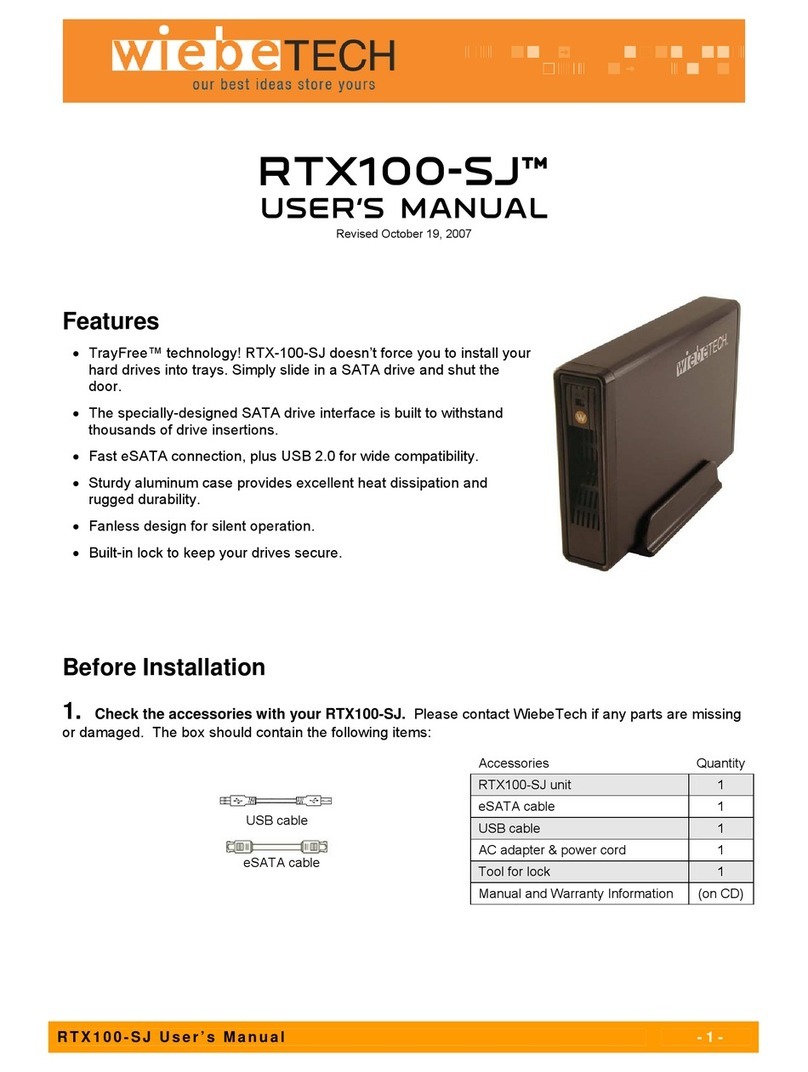
WiebeTech
WiebeTech RTX100-SJ user manual
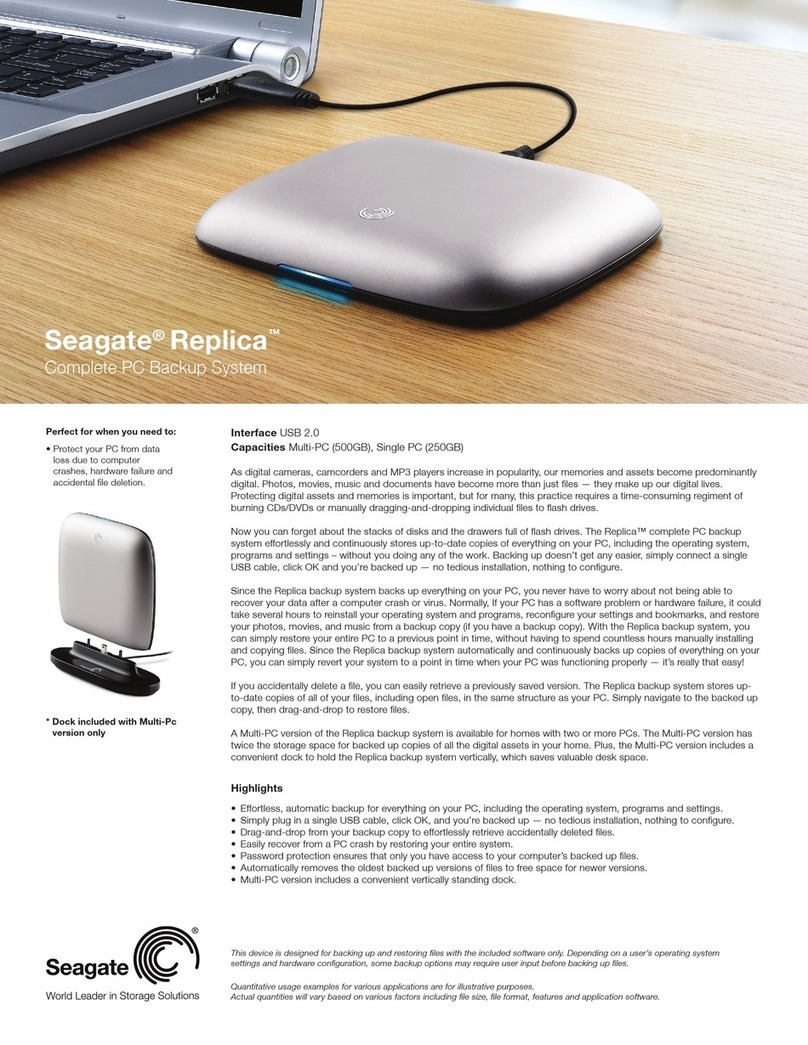
Seagate
Seagate ST902504BDA101-RK - Replica 250 GB External Hard... Specifications

Wise
Wise CFexpress 4.0 CFX4-B Series quick start guide

Addonics Technologies
Addonics Technologies RT54S2HMEU manual
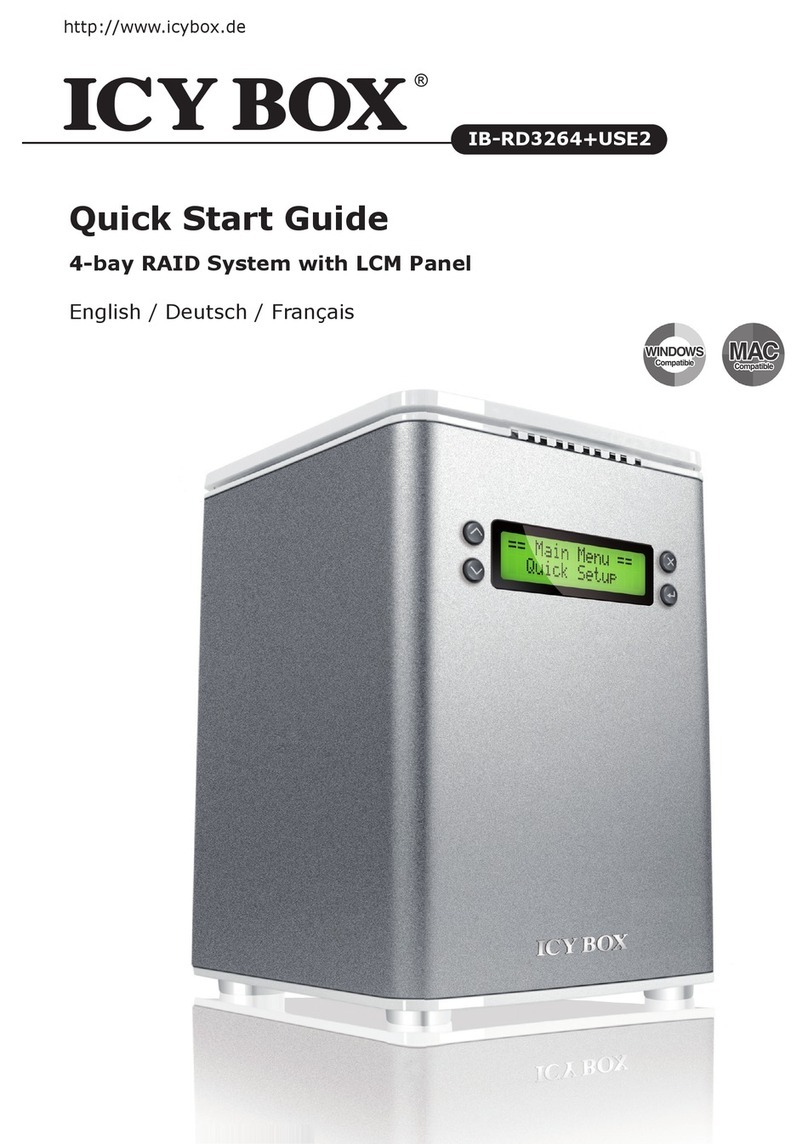
Icy Box
Icy Box IB-RD3264+USE2 quick start guide
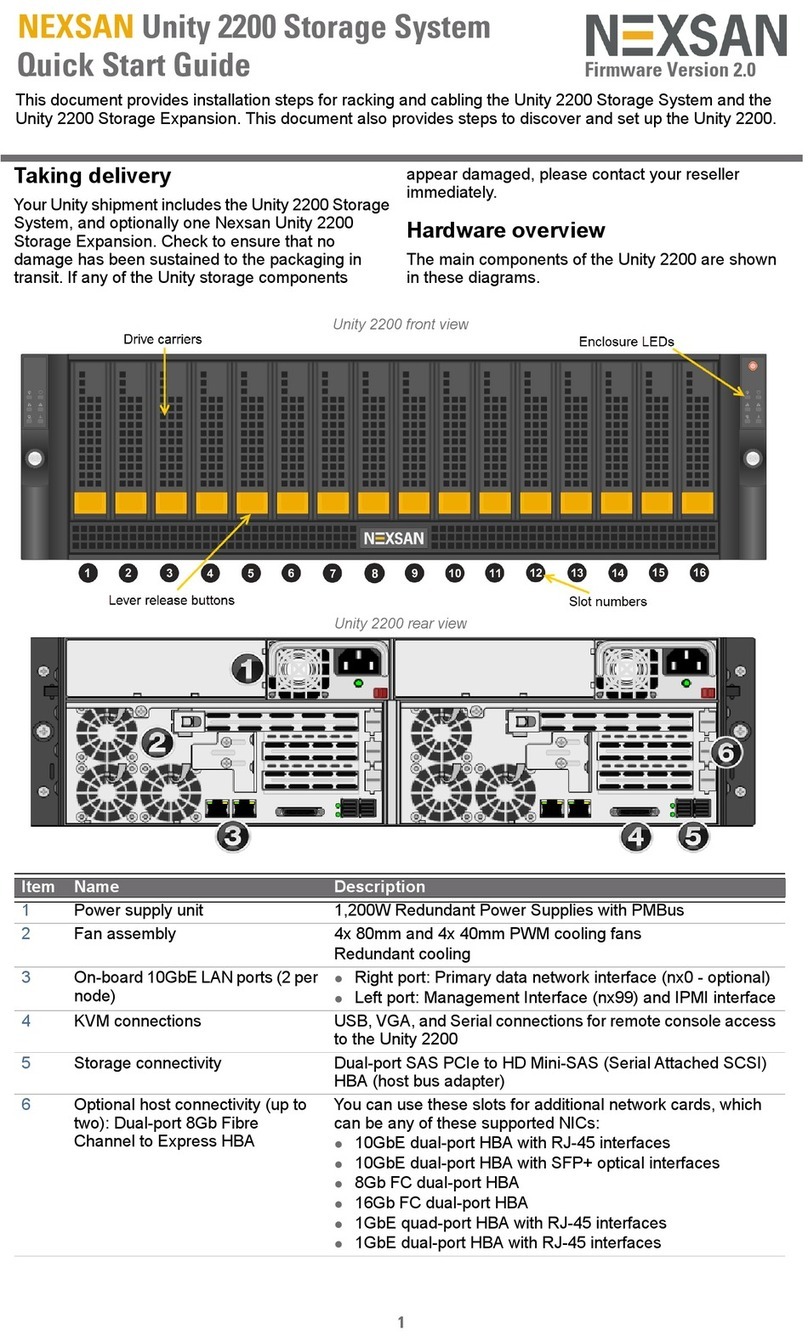
Nexsan
Nexsan Unity 2200 quick start guide
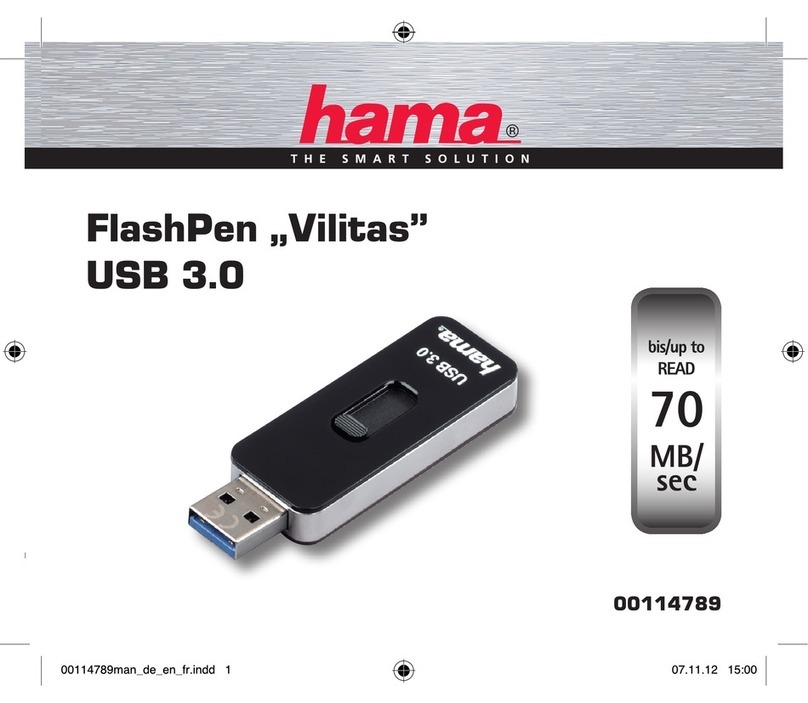
Hama
Hama Vilitas FlashPen USB 3.0 Operating instruction

Seagate
Seagate ST31200W installation guide

Lenovo
Lenovo USB 2.0 Portable Hard Disk Drive user guide
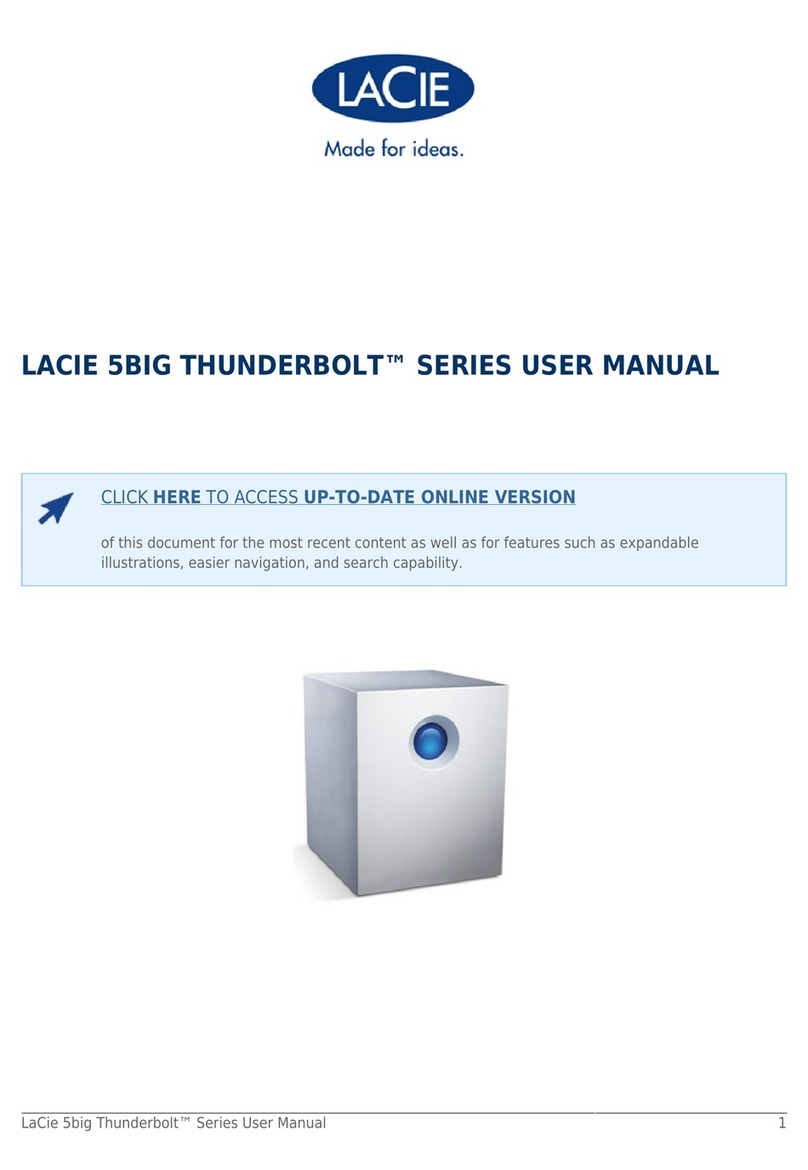
LaCie
LaCie 5big Thunderbolt Series user manual

Dell
Dell PowerVault ML6000 Getting started
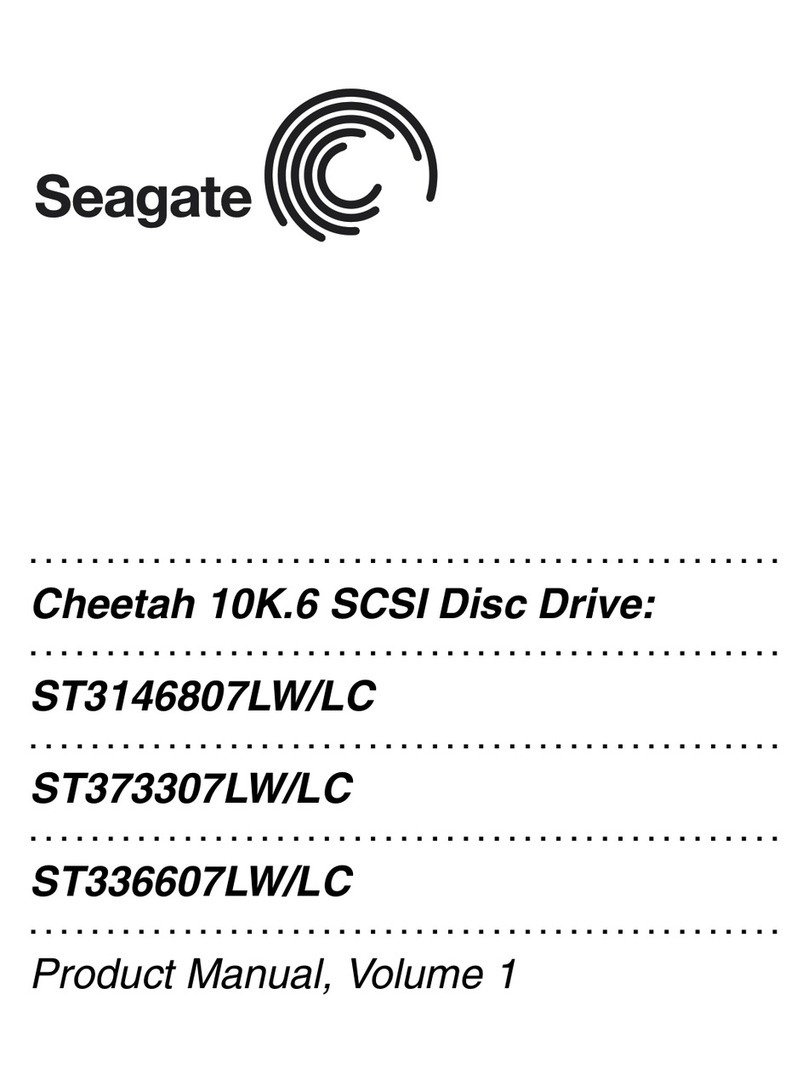
Seagate
Seagate ST3146807LC - Cheetah 147 GB Hard Drive product manual
